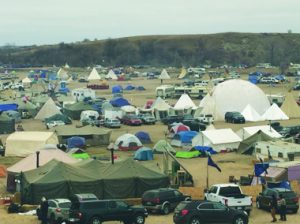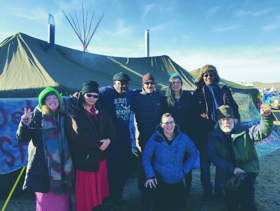Sitting In At Standing Rock : Local Residents Organize Caravan to North Dakota
Story by Rose Carver
The protest at Standing Rock has become a symbolic representation of a hopeful environmental future, as well as one of healthy government dissent.
For the hundreds of Native American tribes (dubbed “Water Protectors”) that have gathered on the land to protest the oil pipeline, it is about protecting the water in the nearby Lake Oahe from the potential for contamination due to a pipeline break, and protecting the ancestral land it would run through, desecrating it  in the eyes of those who have dwelled there for centuries. It is a precarious situation for all parties in finding common ground, and it touches on many facets of the world at large; including a government that claims to protect vulnerable populations from the interest of private companies, and to hold true to the treaties and agreements that were made with America’s Native People.
in the eyes of those who have dwelled there for centuries. It is a precarious situation for all parties in finding common ground, and it touches on many facets of the world at large; including a government that claims to protect vulnerable populations from the interest of private companies, and to hold true to the treaties and agreements that were made with America’s Native People.
Alan Benchich is a long time activist. He served as delegate for Bernie Sanders at the Democratic Convention, and has been a resident of Ferndale for the last year, moving here from Detroit where he had a 38-year career at GM.
Benchich has been an advocate for environmental, economic and social issues for the last 45-years. He claims that if one needs proof of the interests of big corporations being held over the interests of community, one needs to look no further than this very state. Benchich points out that because of the state’s location, sitting in the middle of the largest mass of freshwater in the world, there are constant environmental threats.
“Fracking, the situation in Flint, the water shut-offs in Detroit, the 60-year-old Line 5 oil pipeline that runs under the Mackinac Bridge, Nestle’s company’s sucking aquifers dry on the west side of the state,” Benchich said, “and the source of the threats are corporations whose main concern is profit.”
“You only have to look at Kalamazoo, where the largest inland oil spill in the country occurred in 2010,” Benchich said. “The company, Enbridge, said that the line was completely safe just one week before the enormous spill occurred.”
Benchich felt drawn to show his support to the Water Protectors at Standing Rock because he felt the importance of what was at stake, and so he made the trek to North Dakota to join up in their ranks. Benchich organized a small, local caravan of supporters who traveled to Standing Rock for a week, around Thanksgiving.
The protest is taking a powerful stand against the assumed power of the almighty dollar, but their peaceful protest isn’t without considerable resistance. “When I saw a video on line that showed militarized police using pepper spray, rubber bullets, long range acoustic devices (LRAD) that cause permanent hearing damage and water cannon against unarmed citizens, it was more than I could take,” Benchich said.
Benchich was welcomed into the Oceti camp, which is one of four camps, and the nearest to where the pipeline is being built. He said that the Water Protectors are absolutely devoted to defending the sanctity of the water on their land, and even though the harsh North Dakota Winter is starting to set in, they will not be deterred. “It is hard to describe the energy at Oceti. The camp is a camp of prayer, peace and respect. Weapons, drugs and alcohol are not allowed,” Benchich said. “There is a spirituality that transcends and permeates. Every morning in the cold, pre-dawn darkness, there is a call to prayer at the sacred fire that continuously burns. Hundreds of people walk down to the waters edge and are led in the prayers of various native peoples as the sun rises. At the risk of sounding corny, there is a sense of tranquility and love.”
Benchich describes a vibrant scene, with people from all over the country and the world pitching in and helping out however they can, and their peaceful endurance is history in the making. Representatives of hundreds of different tribes and nations had arrived a few weeks before Benchich did, and there had been a council fire gathering of the elders of the seven tribes that make up the Great Sioux Nation. This was the first gathering of its kind since the 1850s. With such nonviolent intentions, it is hard to imagine the violence that occurs when the authorities arrive.
“The cops not only used water cannons on people in freezing weather, they added anti-freeze, a toxic substance, to it to keep the water cannon from freezing up,” Benchich said. “Snow has now covered the camp, and the North Dakota winter is setting in. The authorities will try to freeze out the water protectors. They will not plow the road and are trying to stop supplies. I was recently told that businesses in the area were instructed not to sell propane to the water protectors. But they will not leave. The Water Protectors are committed to stopping this pipeline. They are committed to protecting the sacred.”
If one feels drawn to join the protest on the frontlines, be forewarned. Benchich recommends that you dress for the Arctic, and to go only if you have a skill to contribute, are able to both be self-sufficient and to contribute work.
http://indiancountrytodaymedianetwork.com/2016/11/23/how-give-and-give-thanks-standing-rock-166566



